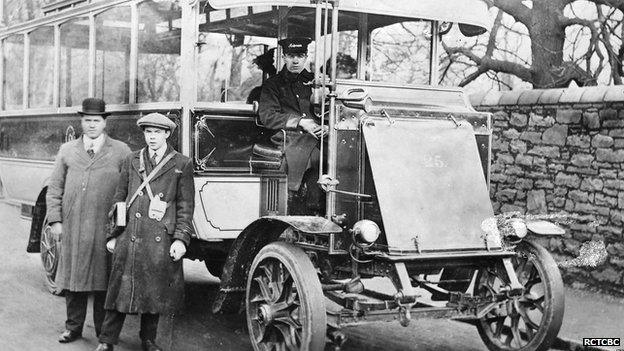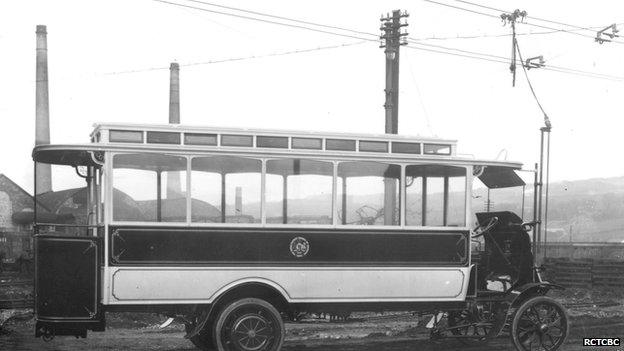Trolley buses could run again, says bus project
- Published

When trolley buses first arrived people were in awe of the new mode of transport
A century ago this week electric trolley buses took to the streets of Wales for the first time, amidst much fanfare in Aberdare.
In a bitter-sweet coincidence it is also the 44th anniversary of the very last trolley bus service in Wales, when Cardiff's 262 returned to its Newport Road depot for the final time in January 1970.
But now the custodian of 262, the only surviving example of a Welsh-built trolley bus, says the time could be right for the trolleys to ride again.
262 has spent almost twenty years being restored by the Cardiff and South Wales Trolley Bus Project, along with 243, a single-decker specially designed to cope with Bute Street's low railway bridge.
Keith Walker, from the project, says all they need now is somewhere to run them.
"Over the years we've had several groups express interest in setting up a loop of overhead cables so we can run the buses, but it's never come to anything.
"While Cardiff Bay was under development there was talk of using them as a tourist attraction, and there were even plans for a transport theme park near Barry at one stage.
"I suppose it goes to show what a hair-brained scheme it was to buy two old trolley buses in the first place, but for people of my age it represents the Cardiff we used to know.
"I grew up watching them whirr around the city, clanking as they changed wires, and it's something I'd love to be able to recreate - who knows, maybe there's room for them at the National History museum in St Fagans?"
Off the tracks
When they were introduced in 1914 trolley buses were meant to be the definitive solution to flexible, quick and affordable mass-transit.
They were cost-effective as the abundance of coal in Wales made for cheap electricity, and the trolley buses could traverse the gradients of the valleys, as unlike trams, they could run without tracks.
But Elfed Davies, the author of 150 Years of Road Passenger Transport in the Cynon Valley, said the novelty soon wore off despite the initial awe.
"For just a penny a ride, the trolley buses connected villages for the first time which either couldn't be reached by train or tram, or where it wasn't profitable to lay tracks.
"People were in awe of them. You have to remember that most people at the time would only have travelled by horse, or maybe on the train if they were lucky, and many people didn't have electricity yet in their homes.
"So to see these sleek metal buses and hear the motors must have been something wonderful.
"But what the operators hadn't reckoned on was the awful ride over the rough valleys ground in the days before pneumatic tyres.
"The bouncing would often dislodge the electrical pick-ups off the overhead cables and leave the bus stranded. In Rhondda they were stopped after just a few months in 1915 because the vibrations they caused were disturbing old mine workings beneath.
"Plus the start of World War One meant that the cheap electricity which was their main advantage wasn't that cheap after all."

The bumpy ride would often dislodge the electrical pick-ups leaving the buses stranded
But on the flatter ground of Cardiff they did flourish, cheaply and quickly beating the traffic of a growing capital.
However, by the 1960s the cost of maintaining the system and advances in diesel engines for motor buses spelt the end for Wales' few remaining trolley bus networks.
Yet transport expert Professor Stuart Cole believes that trolley buses could once again form part of an integrated metro system for South Wales.
"The main reasons for getting rid of the trolley buses were the lack of flexibility with routes and the lower running costs of diesel.
"But since then fuel has risen from 8% of bus operators' total costs to around 25%.
"At the same time advances in battery technology now mean that trolley buses can run away from their overhead wires for considerable distances if required.
"They're cheaper to run, quieter, faster, and most importantly far kinder to the environment.
"The only thing against their reintroduction is a high start-up cost, but as cities across Europe are finding, if you want a sustainable public transport network which will really tempt people away from their cars, then you have to put in the investment."
- Published31 October 2013
- Published8 July 2013